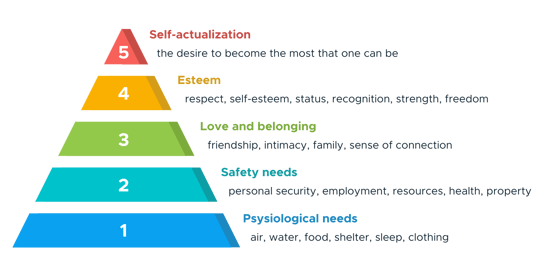Blog
Allen Interactions Partners with HR.com to Equip the HR Community in ...
Employee burnout is a topic that has been on the mind of researchers for decades. It’s not new—but lately, it seems to be a “hot” topic related to ...


Breaking Through Burnout: Strategies to Increase Employee Retention
By Claire Letts Lesney | June 09, 2022 | Strategic Consulting | 0 Comments
Employee burnout is a topic that has been on the mind of researchers for decades. It’s not new—but lately, it seems to be a “hot” topic related to The Great Resignation and is impacting organizations across the globe.
Previously, careers in human resources, education, and healthcare were top candidates for burnout, and it has officially been recognized as an occupational hazard in those fields. Today, employees feeling the effects of prolonged professional stress and burnout are not limited to any one industry or profession. It is happening everywhere, and it can happen to anyone.
With massive adjustments in our professional environment, lines have been blurred between professional and personal time. Organizations are still figuring out how to best support a decentralized workforce while expectations remain the same. This disruption has rocked an employee’s basic need for safety and belonging.
Maslow's hierarchy of needs
Maslow’s Hierarchy of Needs is a well-known psychological tool that is used to identify basic human needs. It is often used in the workplace to determine where employers should focus to more effectively motivate employees and make sure their needs are met. A healthy and engaged workforce is full of employees who have reached the top level (5) of Maslow’s Hierarchy of Needs (Self-Actualization: they understand their skills, abilities, and what they are capable of handling). When employees feel safe, supported, have a sense of belonging, and are self-actualized, they may influence those around them.
Employees won’t reach the top level, or even reach the next level of needs, until all of the lower-level needs are met. If they get stuck on any level they may experience depression or stress. For example, if an employee has all of their safety needs met (2), but does not feel like they belong in their organization (3), they may start to feel stressed, and eventually, will experience burnout.
Leaders need to strategically address organizational culture, but often, where employees are feeling burnout, leadership is as well. A culture that becomes toxic will lead to employee burnout and, subsequently, resignations.
What is burnout?
According to a recent Brandon Hall Group Study, only:
- 5% of employees feel the career opportunities available to them align with their personal and professional goals
- 5% of employees thrive in their current company culture
- 3% of employees feel that their work stress is manageable
Burnout is a psychological response to chronic interpersonal stressors in the workplace. It manifests as a state of physical or emotional exhaustion that also involves a sense of reduced accomplishment and loss of personal identity.
Burnout has been associated with various forms of negative reactions and job withdrawal, including job dissatisfaction, low organizational commitment, absenteeism, and intention to leave the job. People who are experiencing burnout in the workplace can also have a negative impact on their colleagues, both by causing greater personal conflict and by disrupting job tasks.
How to identify employee burnout
Identifying work stress in employees can be challenging as people often don’t speak up about it, and sometimes, they don’t even realize that they are experiencing unmanageable levels of stress.
There are three key traits that employees may display when responding to burnout.
- Exhaustion
- Cynicism
- Inefficacy
Unlike acute stress reactions which develop in response to specific critical incidents, burnout is a cumulative reaction to ongoing stressors.
Exhaustion
Exhaustion represents an individual's level of stress. This stress can come from feelings of being overextended, overwhelmed, and depleted of emotional and physical resources.
Cynicism
Cynicism represents a negative and excessively detached response to various aspects of the job. It usually develops in response to an overload of exhaustion.
Inefficacy
Inefficacy represents the self-evaluation dimension of burnout. It represents feelings of incompetence and a lack of achievement in work. This can develop in response to a work situation with chronic, overwhelming demands (that may also contribute to exhaustion or cynicism).
What causes burnout?
Often, burnout is thought of as an individual problem solvable by practicing mindfulness and working on prioritizing time. In reality, burnout is about the workplace, not the people. Some of the most common causes of burnout are an overwhelming workload, unclear job expectations, dysfunctional workplace dynamics, limited upward mobility, lack of communication and social support, and a lack of control.
The Areas of Worklife Scale (AWS) identifies six main areas that cause burnout: workload, control, reward, community, fairness, and values. This model says that mismatches between people and their job in these areas affect an individual's level of experienced burnout, which in turn affects outcomes such as job performance, social behaviors, and personal wellbeing.
.png?width=492&name=Services%20-%20blog%20graphics%20(1).png)
The greater the mismatch between the person and the job, the higher likelihood of burnout. On the other hand, the greater the match is between the person and the job, the greater likelihood of engagement.
Engagement is considered to be the opposite of burnout and is defined with the opposite three dimensions
- State of high energy
- Strong involvement
- Sense of efficacy
The 6 Stressors
Workload
Employees experiencing work overload will be unable to meet the demands of the job. When this is established as a chronic job condition, there is little opportunity to rest, recover, and restore balance. In contrast, a sustainable and manageable workload provides opportunities for employees to use and refine existing skills, and to become effective in new areas of activity.
Control
Employees feeling a lack of control in their work environment will not be able to feel effective in their job. This often happens when an employee feels unable to influence decisions that directly impact them, such as scheduling, workload, or resources. In contrast, when employees have the capacity to influence decisions that affect their work, exercise professional autonomy, and gain access to the resources necessary to do an effective job, they are likely to experience job engagement.
Reward
Rewards can be a powerful motivator to shape employee behavior. Insufficient recognition and rewards (whether financial, institutional, or social) will increase an employee’s vulnerability to burnout because it devalues both their work and their sense of self. In contrast, consistent rewards allow for intrinsic satisfaction and job engagement.
Community
Employees feeling a lack of support, lack of trust, or an unresolved conflict will have a much greater risk of burnout. In contrast, when job-related relationships are working well, social support and effective means of working out disagreements allow for job engagement.
Fairness
Employees will use the quality of work procedures and their treatment during any decision-making process to index their place in the community. An employee who feels that the decisions at work are fair and equitable will be engaged, while employees who feel that the decisions are not fair or equitable will likely experience cynicism and feel as though they are not respected in the workplace.
Values
Employees are attracted to a workplace initially due to the ideals and motivations of the workplace, which go beyond just monetary value. When there is a gap between individual and organizational values, employees will find themselves making a trade-off between the work they want to do and the work they have to do. This will lead to burnout and feelings of cynicism.
These 6 stressors stem from company culture, and the solution to addressing burnout is to analyze the current organizational culture and the traits within.
Burned-out employees are 63% more likely to take a sick day and 2.6 times as likely to be actively seeking a different job.
Managing burnout
The first step to managing burnout is understanding your organizational culture and where your employees currently are. Leadership needs to be self-aware first, as employee burnout is often not limited to one part of the organization. Social awareness is an important next step to make decisions that lead to engagement.
Being socially aware of employees and their mindset starts with management. A powerful way to connect with team members is called Management by Wandering Around (MBWA) and it’s exactly what it sounds like. Managers who talk to employees, work with them, ask questions, and help when needed are implementing a strategy that promotes engagement. This method requires active listening, observation, and recognition.
An important part of MBWA is to listen and observe more than you talk. Sound inquisitive rather than intrusive. You want to promote open and receptive communication and refrain from judgment.
Keep in mind—just being physically present with your people is not enough. The actions you take to solve problems will be the most effective tool for engagement with employees.
"Teams creating interventions can guide leaders to strengthen fragile relationships before they break and positively transform the workplace."
- Dr. Christina Barss, Lead Transformation Expert
Warning signs of burnout
While observing, look for signs of employee burnout that align with the three key traits of exhaustion, cynicism, and inefficacy.
- Taking more time-off/ sick time than usual
- Being late to start their workdays
- Being late or absent from meetings
- Not meeting agreed-upon deadlines
- Inconsistent productivity levels
- Lack of innovation/ problem-solving
- Resistance to change
- Slow adaption to new processes
- Drop in teamwork/ participation
- Lack of trust
- Snide remarks
Keep an eye out for the employees who may be in “survival mode”. Don’t forget to appreciate those who are still showing up—retaining employees involves focusing on the whole self. You can’t retain an employee who has already checked out.
Strategies to increase retention
Many organizations try to treat burnout after it has occurred, but some focus on how to prevent burnout by promoting engagement. Observing, listening to, and connecting with your employees is the first step to understanding how to adjust your culture. The following strategies may be valuable to consider and align with your organization's goals. Keep adjusting your culture based on feedback—sustainable plans will adapt with the organization as it and its people grow and change.
- Have open conversations with your team to identify workload and levels of overwhelm or underwhelm (lack of work can lead to feelings of underappreciation or uninvolvement)
- Determine flexible work arrangements and create policies that promote work-life balance (i.e. unplugging during scheduled time off, avoiding overtime work)
- Communicate the importance of taking breaks and stepping away from tasks to boost productivity, reduce stress, and help increase creativity
- Promote open and honest communication of new initiatives (Employee advocacy platforms like EveryoneSocial allow for regular communication and feedback) and help employees know what is expected of them now and in the future
- Create and communicate an internal conflict resolution plan based on trust
- Provide financial, institutional, and social rewards such as a wellness program, mental health benefits, bonuses, lunches, and special events
- Keep in mind that you should also reward your team with appreciation and acknowledgment
- Allow employees to pursue advancement opportunities. Side projects allow employees to harness creativity, and additional learning opportunities allow you to take part in their personal development and tap into their skills and strengths you may be unaware of
- Continue to observe and listen to employee feedback in order to adapt and create new plans for change
The right strategies are different for every organization and should be built around organizational culture. It’s important to listen to employee feedback and implement strategies to address current challenges. However, the most important information you can collect to enact change comes from observation. Your people and their well-being are at the center of your success.

About the Author: Claire Letts Lesney
(cletts@alleni.com) is a digital marketer and brand champion for Allen Interactions. Experienced in topics including emerging technology, design thinking, learning ecosystems, and instructional design, Claire focuses on facilitating purposeful knowledge sharing within her organization. Working with Fortune 500s, Government, and startup companies, she oversees marketing campaigns, implements strategies and storytelling, and researches to stay up-to-date on industry trends and innovations.
Comments
Would you like to leave a comment?
Related Blog Posts

By: Claire Letts Lesney | Jul, 2020
Category: News

Blog
Allen Interactions Named Top 20 Custom Content Development Company
Employee burnout is a topic that has been on the mind of researchers for decades. It’s not new—but lately, it seems to be a “hot” topic related to ...
By: Claire Letts Lesney | Jun, 2020
Category: News
.png?width=316&name=Services%20-%20Six%20Conversation%20Examples%20For%20Selling%20Performance-Changing%20Learning%20(1).png)
Blog
Six Conversation Examples For Selling Performance-Changing Learning
Employee burnout is a topic that has been on the mind of researchers for decades. It’s not new—but lately, it seems to be a “hot” topic related to ...
By: Claire Letts Lesney | Jul, 2021
Category: Custom Learning, Strategic Consulting


